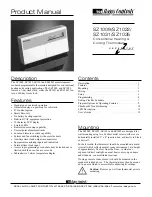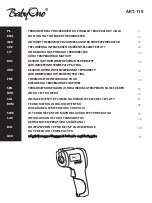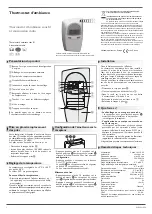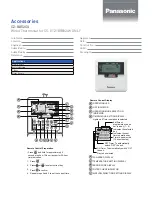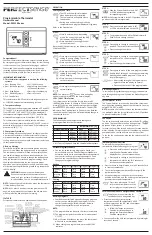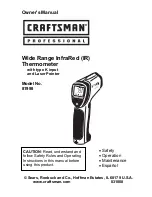
R
2800 LAURA LANE
l
MIDDLETON, WI 53562
l
(800) 288-9383
l
FAX (608) 836-9044
l
www.tcs-basys.com
10
P + I OPTION
The SZ1009, SZ1022, SZ1031 and SZ1035 also have a P+I
option. Without enabling this option, stages turn on and off
based on temperature vs. setpoint alone, as described above.
By enabling this option, you allow a time factor to be added.
This is useful when you are forced to have a large differential
due to equipment size. At times when the building load is low,
the temperature could potentially sit a few degrees off setpoint
for some time. With the time factor added, the thermostat
would compensate for this, turning on the equipment even
though the temperature had not reached the limits described
above.
DI2 COOL LOCKOUT
DI2 may be set as cool lockout for operation with economiz-
ers. An outdoor temperature switch may be wired in such that
when DI2 is closed, the second stage of cooling is disabled.
SMART RECOVERY
“Smart Recovery” may be enabled to insure occupant comfort
while saving money. It takes the building load into considera-
tion and ramps the setpoint when going from the unoccupied
mode to the occupied mode. At the beginning of the occupied
mode, the occupied setpoint will be reached, many times with-
out the need for the second stage to come on. This feature is
automatically disabled when DI3 is set to external time clock.
AUXILIARY OUTPUT
An auxiliary relay output is available to output a signal based
on the occupancy status. It is commonly used with an econo-
mizer minimum position control, or to signal an outdoor air
damper to open in occupied times in lieu of an economizer. It
may also be used for lighting or hot water heaters. Keep in
mind that although it is an isolated relay (separate common
terminal), it is rated at 24 VAC. For loads that exceed this, use
an external relay. It may be set to be open (NO) or closed
(NC) when the thermostat is operating in the occupied mode,
and will be the opposite during the unoccupied mode.
BUILT-IN DELAYS
The SZ1009, SZ1022, SZ1031 and SZ1035 have delays built
into the programming sequences to protect equipment. The fan
has a minimum on and off time of 30 seconds. When the fan
is in AUTO mode, it will come on 30 seconds before the heat-
ing or cooling stages are allowed to sequence on, and remain
on for 2 minutes after the heating or cooling stages sequence
off. Each stage has a minimum on and off time of two min-
utes. There is a minimum of two minutes between when one
stage turns on until the next stage is allowed to turn on, as
well as when one stage turns off until the next stage is allowed
to turn off.
DELAY ON POWER UP
The SZ1009, SZ1022, SZ1031 and SZ1035 have an adjustable
delay on power up. When several thermostats are used at one
location, and the power goes out, most thermostats turn all of
the units back on at the same time on regain of power, creating
a peak. The thermostat allows you to set a value, in seconds,
where no outputs are allowed to turn on for that length of time
on power up. Setting each unit to a different delay allows you
to soft start your system, and thus prevent this peak.
Checkout & Troubleshooting
CHECKOUT
Note:
The fan has a minimum on and off time of 30 seconds.
The heating and cooling stages have a minimum on and off
time of 2 minutes.
You may verify the status of heating and cooling stages and
fan in monitoring screens #5, #6, and #7, which are accessed
by pressing the SERVICE STATUS button.
1. Verify all wiring prior to powering the thermostat.
2. Turn power on. The thermostat will display a momentary
screen with the model number , and then the main monitor-
ing screen with the time, day, date (SZ1031 and SZ1035
only), and current temperature.
3. Press the PROGRAM SETUP button until you reach the
screen #14 which allows you to set the occupant setpoint
adjustment limits. Change this to +/-20 °F (11.1 °C). Press
the PROGRAM SETUP button once more to store the
change. Then press the SERVICE STATUS button once to
exit the programming.
4. Press the FAN SWITCH button to access the fan mode and
change the mode to AUTO. Press the FAN SWITCH but-
ton once more to store the change. Press the SYSTEM
SWITCH button to access the system mode and change the
mode to AUTO. Press the SYSTEM SWITCH button once
more to store the change.
5. Verify that the thermostat is operating in the occupied mode
by making sure that the top LED is lit. If not, press the
OVERRIDE button. The LED should light up.
6. Take note of the current temperature reading. Press the
WARMER (up) button. The setpoint adjustment screen
should now be showing. Press the WARMER button until
the heating setpoint is greater than the current temperature
by at least five degrees. The fan will come on. The heat-
ing stage(s) will sequence on after 30 seconds.
7. Press the cooler (down) button until the heating setpoint is
one degree less than the current temperature. The heating
stage(s) will sequence off. The fan will turn off 2 minutes
after the last heating stage.
8. Press the cooler button until the cooling setpoint is less than
the current temperature by at least five degrees. The fan
will come on. The cooling stage(s) will sequence on after
30 seconds.
MON
TCS V1.0
11-19-01
12:00AM
72F

